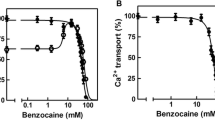Summary
Vascular perfusion of rat hind limbs with a Ca2+-free physiological solution containing ethylenediaminetetraacetate, when followed by a physiological solution with normal concentration of Ca2+, caused a marked rise of creatine kinase (CK) in the venous effluent. When calcium channel blockers were present in the perfusing solutions, no rise of CK occurred. On histological sampling of perfused muscles, CK rise was roughly correlated with muscle fiber damage of the appropriate muscles. Removal of calcium from the plasmalemma of muscle fibers appears to prevent closure of calcium channels, making the muscle fibers susceptible to a deleterious influx of extracellular calcium. This influx can be prevented by the presence of calcium channel blockers in the perfusates.
Similar content being viewed by others
References
Armani M, Angelini C, Cacciavillani M, Ausoni S (1985) Calcium paradox phenomenon in mammalian muscle: an experimental model for the study of pathogenesis of opaque fibers. Ital J Neurol Sci [Suppl] 5:111–115
Baker JE, Hearse DJ (1983) Slow calcium channel blockers and the calcium paradox: comparative studies in the rat with seven drugs. J Mol Cell Cardiol 15:475–485
Canal N, Frattola L, Nemni R, Tiby V, Piolti R, Tonini C, Iannaccone S (1984) Serotonin-induced muscular damage in hypercalcemic rats: a morphological and biochemical study. Neurology 34:290 (Abstract)
Carpenter S, Karpati G (1984) Calcium paradox in skeletal muscles. Neurology [Suppl] 34:193
Carpenter S, Karpati G, Armani M (1983) Calcium paradox in skeletal muscle. Neuroscience Abstracts, Part 1, 351
Costantin LL (1968) The effect of calcium on contraction and conductance thresholds in frog skeletal muscle. J Physiol 195:119–132
Eastwood AB, Wood DS, Bock KR, Sorensen MM (1979) Chemically skinned mammalian skeletal muscle. I. The structure of skinned rabbit psoas. Tissue Cell 11:553–566
Fleckenstein A, Frey M, Fleckenstein-Grun G (1983) Consequences of uncontrolled calcium entry and its prevention with calcium antagonists. Eur Heart J [Suppl] 4:43–50
Karpati G, Carpenter S (1982) Micropuncture lesions of skeletal muscle cells: a new experimental model for the study of muscle cell damage, repair and regeneration. In: Schotland D (ed) Disorders of motor unit. John Wiley and Sons, New York, pp 517–533
Lüttgau HC (1983) The action of calcium ions on potassium contractures of single muscle fibers. J Physiol 168:679–697
Martonosi AN (1983) The regulation of cytoplasmic Ca2+ ion concentration in muscle and non-muscle cells. In: Stracher A (ed) Muscle and non-muscle motility, molecular biology series, vol 1. Academic Press, New York, pp 233–357
Paradise NF, Swayze CR, Shin DH, Fox IJ (1971) Perfusion heterogeneity in skeletal muscle using tritiated water. Am J Physiol 220:1107–1115
Ruigrok TJC, Poole-Wilson PA (eds) (1983) The calcium paradox and the heart. Aspects of myocardial intergrity and protection. Eur Heart J [Suppl H] 4:1–168
Soza M, Karpati G, Carpenter S (1984) Calcium paradox in skeletal muscles: physiological observations. Neuroscience Abstracts, Part 2:784
Soza M, Karpati G, Carpenter S, Prescott S (1985) Calcium channel blockers mitigate calcium-induced damage of skeletal muscle fibers. Neurology [Suppl] 35:206
Soza M, Karpati G, Carpenter S (1986) Calcium paradox in skeletal muscles: physiological and microscopic observations. Muscle Nerve 9:222–232
Tsien RW (1983) Calcium channels in excitable cell membranes. Ann Rev Physiol 45:341–358
Wood DS, Zollman J, Reuben JP, Brandt PW (1975) Human skeletal muscle: properties of the “chemically skinned” fiber. Science 187:1075–1076
Zimmerman ANE, Hülsmann WC (1966) Paradoxical influence of calcium ions on the permeability of the cell membranes of the isolated heart. Nature 211:646–647
Author information
Authors and Affiliations
Additional information
Supported by the Medical Research Council of Canada, the Muscular Dystrophy Association of Canada and the Gildemeister Foundation
Rights and permissions
About this article
Cite this article
Soza, M., Karpati, G., Carpenter, S. et al. Calcium-induced damage of skeletal muscle fibers is markedly reduced by calcium channel blockers. Acta Neuropathol 71, 70–75 (1986). https://doi.org/10.1007/BF00687964
Received:
Accepted:
Issue Date:
DOI: https://doi.org/10.1007/BF00687964




